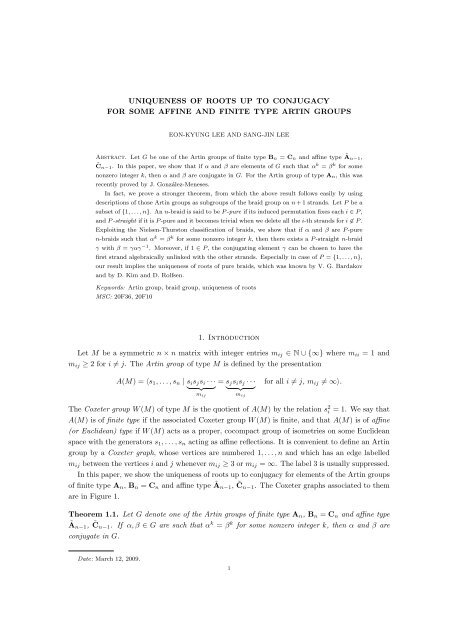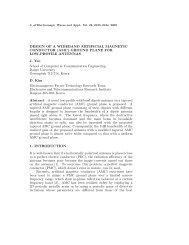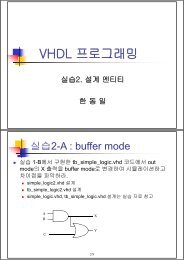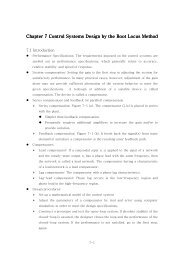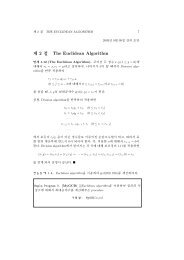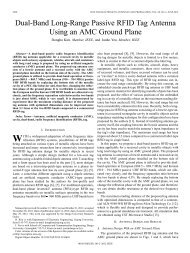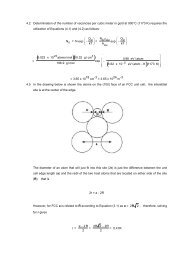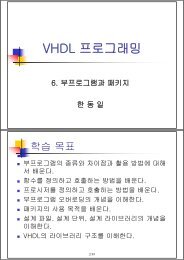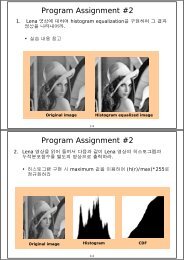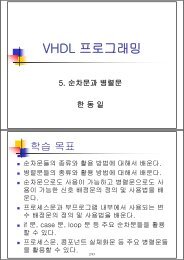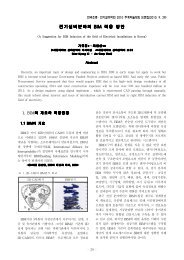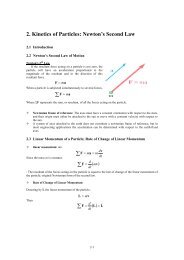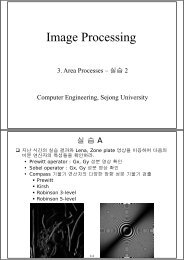UNIQUENESS OF ROOTS UP TO CONJUGACY FOR SOME ...
UNIQUENESS OF ROOTS UP TO CONJUGACY FOR SOME ...
UNIQUENESS OF ROOTS UP TO CONJUGACY FOR SOME ...
Create successful ePaper yourself
Turn your PDF publications into a flip-book with our unique Google optimized e-Paper software.
<strong>UNIQUENESS</strong> <strong>OF</strong> <strong>ROOTS</strong> <strong>UP</strong> <strong>TO</strong> <strong>CONJUGACY</strong><br />
<strong>FOR</strong> <strong>SOME</strong> AFFINE AND FINITE TYPE ARTIN GRO<strong>UP</strong>S<br />
EON-KYUNG LEE AND SANG-JIN LEE<br />
Abstract. Let G be one of the Artin groups of finite type B n = C n and affine type Ãn−1,<br />
˜C n−1 . In this paper, we show that if α and β are elements of G such that α k = β k for some<br />
nonzero integer k, then α and β are conjugate in G. For the Artin group of type A n , this was<br />
recently proved by J. González-Meneses.<br />
In fact, we prove a stronger theorem, from which the above result follows easily by using<br />
descriptions of those Artin groups as subgroups of the braid group on n + 1 strands. Let P be a<br />
subset of {1, . . . , n}. An n-braid is said to be P -pure if its induced permutation fixes each i ∈ P ,<br />
and P -straight if it is P -pure and it becomes trivial when we delete all the i-th strands for i ∉ P .<br />
Exploiting the Nielsen-Thurston classification of braids, we show that if α and β are P -pure<br />
n-braids such that α k = β k for some nonzero integer k, then there exists a P -straight n-braid<br />
γ with β = γαγ −1 . Moreover, if 1 ∈ P , the conjugating element γ can be chosen to have the<br />
first strand algebraically unlinked with the other strands. Especially in case of P = {1, . . . , n},<br />
our result implies the uniqueness of roots of pure braids, which was known by V. G. Bardakov<br />
and by D. Kim and D. Rolfsen.<br />
Keywords: Artin group, braid group, uniqueness of roots<br />
MSC: 20F36, 20F10<br />
1. Introduction<br />
Let M be a symmetric n × n matrix with integer entries m ij ∈ N ∪ {∞} where m ii = 1 and<br />
m ij ≥ 2 for i ≠ j. The Artin group of type M is defined by the presentation<br />
A(M) = 〈s 1 , . . . , s n | s i s j s i · · · = s j s i s j · · ·<br />
} {{ } } {{ }<br />
m ij<br />
m ij<br />
for all i ≠ j, m ij ≠ ∞〉.<br />
The Coxeter group W (M) of type M is the quotient of A(M) by the relation s 2 i = 1. We say that<br />
A(M) is of finite type if the associated Coxeter group W (M) is finite, and that A(M) is of affine<br />
(or Euclidean) type if W (M) acts as a proper, cocompact group of isometries on some Euclidean<br />
space with the generators s 1 , . . . , s n acting as affine reflections. It is convenient to define an Artin<br />
group by a Coxeter graph, whose vertices are numbered 1, . . . , n and which has an edge labelled<br />
m ij between the vertices i and j whenever m ij ≥ 3 or m ij = ∞. The label 3 is usually suppressed.<br />
In this paper, we show the uniqueness of roots up to conjugacy for elements of the Artin groups<br />
of finite type A n , B n = C n and affine type Ãn−1, ˜C n−1 . The Coxeter graphs associated to them<br />
are in Figure 1.<br />
Theorem 1.1. Let G denote one of the Artin groups of finite type A n , B n = C n and affine type<br />
à n−1 , ˜C n−1 . If α, β ∈ G are such that α k = β k for some nonzero integer k, then α and β are<br />
conjugate in G.<br />
Date: March 12, 2009.<br />
1
2 EON-KYUNG LEE AND SANG-JIN LEE<br />
A n<br />
à n−1<br />
B n<br />
˜Cn−1<br />
Figure 1. Coxeter graphs<br />
In fact, we prove a stronger theorem. Before stating it, let us explain the motivations. The<br />
Artin group A(A n ) is well-known as B n+1 , the braid group on n + 1 strands. The generators of<br />
B n+1 are usually written as σ i , hence it has the presentation<br />
B n+1 =<br />
〈<br />
σ 1 , . . . , σ n<br />
∣ ∣∣∣ σ i σ j = σ j σ i if |i − j| > 1,<br />
σ i σ j σ i = σ j σ i σ j if |i − j| = 1.<br />
The following are well-known theorems on uniqueness of roots of braids.<br />
Theorem 1.2 (J. González-Meneses [Gon03]). Let α and β be n-braids such that α k = β k for<br />
some nonzero integer k. Then α and β are conjugate in B n .<br />
Theorem 1.3 (V. G. Bardakov [Bar92], D. Kim and D. Rolfsen [KR03]). Let α and β be pure<br />
braids such that α k = β k for some nonzero integer k. Then α and β are equal.<br />
Theorem 1.2 was conjectured by G. S. Makanin [Mak71] in the early seventies, and proved<br />
recently by J. González-Meneses. Thus the new contribution of Theorem 1.1 is for the Artin<br />
groups of type B n = C n , Ãn−1 and ˜C n−1 . Theorem 1.3 was first proved by V. G. Bardakov by<br />
combinatorial arguments, and it follows easily from the bi-orderability of pure braids by D. Kim<br />
and D. Rolfsen. (To see this, let < be a bi-ordering of pure braids. If α > β (resp. α < β), then<br />
α k > β k (resp. α k < β k ) for all k ≥ 1. Therefore, α k = β k implies α = β.)<br />
It is worth mentioning that D. Bessis showed the uniqueness of roots up to conjugacy for<br />
periodic elements in the braid groups of irreducible well-generated complex reflection groups, and<br />
hence for periodic elements in finite type Artin groups: if G is the braid group of an irreducible<br />
well-generated complex reflection group and if α, β ∈ G are such that α has a central power and<br />
α k = β k for some nonzero integer k, then α and β are conjugate in G [Bes06, Theorem 12.5 (ii)].<br />
Comparing the above two theorems, we can see that one obtains a stronger result for pure<br />
braids. Motivated by the above observation, we study the case of “partially pure” braids—that is,<br />
braids some of whose strands are pure. Moreover, the Artin groups A(B n ), A(Ãn−1) and A( ˜C n−1 )<br />
are isomorphic to some subgroups of B n+1 , which can be described by pure strands and linking<br />
number of the first strand with the other strands. In order to deal with “partially pure” braids<br />
and elements of those Artin groups simultaneously, we introduce the following definitions.<br />
Definition 1.4. For an n-braid α, let π α denote the induced permutation of α.<br />
• For an n-braid α and an integer 1 ≤ i ≤ n, we say that α is i-pure, or the i-th strand of<br />
α is pure, if π α (i) = i.<br />
• Let B n,1 denote the subgroup of B n consisting of 1-pure braids.<br />
• Let P ⊂ {1, . . . , n}. An n-braid α is said to be P -pure if α is i-pure for each i ∈ P . Note<br />
that {1, . . . , n}-pure braids are nothing more than pure braids in the usual sense.<br />
〉<br />
.
<strong>UNIQUENESS</strong> <strong>OF</strong> <strong>ROOTS</strong> <strong>FOR</strong> <strong>SOME</strong> ARTIN GRO<strong>UP</strong>S 3<br />
Figure 2. This braid is {1, 4, 5}-pure, {1, 4}-straight, {1, 5}-straight and 1-unlinked.<br />
• Let P ⊂ {1, . . . , n}. An n-braid is said to be P -straight if it is P -pure and it becomes<br />
trivial when we delete all the i-th strands for i ∉ P . Note the following: if |P | = 1, then<br />
a braid is P -pure if and only if it is P -straight; if |P | = n and α is a P -straight n-braid,<br />
then α is the identity; a braid α is called a brunnian braid if it is P -straight for all P with<br />
|P | = n − 1.<br />
For example, the braid in Figure 2 is {1, 4, 5}-pure, {1, 4}-straight and {1, 5}-straight.<br />
Definition 1.5. There is a homomorphism lk : B n,1 → Z which measures the linking number<br />
of the first strand with the other strands: let σ 1 , . . . , σ n−1 be the Artin generators for B n , then<br />
B n,1 is generated by σ 2 1, σ 2 , σ 3 , . . . , σ n−1 , and the homomorphism lk is defined by lk(σ 2 1) = 1<br />
and lk(σ i ) = 0 for i ≥ 2. Note that lk(·) is a conjugacy invariant in B n,1 because lk(γαγ −1 ) =<br />
lk(γ) + lk(α) − lk(γ) = lk(α) for any α, γ ∈ B n,1 . A braid α is said to be 1-unlinked if it is 1-pure<br />
and lk(α) = 0. For example, the braid in Figure 2 is 1-unlinked.<br />
It is well known that the following isomorphisms hold [Cri99, All02, CC05, BM05]:<br />
A(B n ) ≃ B n+1,1 ;<br />
A(Ãn−1) ≃ {α ∈ B n+1,1 | α is 1-unlinked};<br />
A( ˜C n−1 ) ≃ {α ∈ B n+1,1 | α is {1, n + 1}-pure}.<br />
As we do not need to consider the Artin group A(A n ) due to Theorem 1.2, it suffices to consider<br />
1-pure braids. From now on, we restrict ourselves to B n,1 , the group of 1-pure braids on n strands.<br />
Exploiting the Nielsen-Thurston classification of braids, we establish the following theorem.<br />
Theorem 1.6. Let P be a subset of {1, . . . , n} with 1 ∈ P . Let α and β be P -pure n-braids such<br />
that α k = β k for some nonzero integer k. Then there exists a P -straight, 1-unlinked n-braid γ<br />
with β = γαγ −1 .<br />
Applying Theorem 1.6 to {1}-pure (n +1)-braids (resp. {1, n +1}-pure (n +1)-braids), we have<br />
Theorem 1.1 for A(B n ) and A(Ãn−1) (resp. for A( ˜C n−1 )).<br />
We close this section with some remarks. An easy consequence of Theorem 1.1 is the following.<br />
Let G denote one of the Artin groups of finite type A n , B n = C n and affine type<br />
à n−1 , ˜C n−1 . Let α, β ∈ G and let k be a nonzero integer. Then α is conjugate<br />
to β if and only if α k is conjugate to β k .<br />
Theorem 1.3 follows easily from Theorem 1.6: Let α and β be pure n-braids with α k = β k . In<br />
our terminology, both α and β are {1, . . . , n}-pure, hence there exists a {1, . . . , n}-straight n-braid<br />
γ such that β = γαγ −1 . Because γ is {1, . . . , n}-straight, we have γ = 1, hence α = β.<br />
Theorem 1.1, even for A(B n ), does not follow easily from Theorem 1.2 because there are 1-pure<br />
braids that are conjugate in B n , but not in the subgroup B n,1 , as in the following example.
4 EON-KYUNG LEE AND SANG-JIN LEE<br />
α 1 = σ 2 1 β 1 = σ 2 2 α 2 = σ 2 1σ 4 2 β 2 = σ 2 2σ 4 1<br />
Figure 3. α i , β i ∈ B n,1 are conjugate in B n but not in B n,1 .<br />
Example 1.7. Consider the 1-pure 3-braids which are depicted in Figure 3:<br />
{<br />
{<br />
α 1 = σ1,<br />
2 α 2 = σ 2<br />
β 1 = σ2,<br />
2 and<br />
1σ2,<br />
4<br />
β 2 = σ2σ 2 1.<br />
4<br />
Because ∆α i ∆ −1 = β i for i = 1, 2, where ∆ = σ 1 σ 2 σ 1 , the braid α i is conjugate to β i in B 3 .<br />
However, α i is not conjugate to β i in B 3,1 for i = 1, 2 because lk(α 1 ) = lk(α 2 ) = 1, lk(β 1 ) = 0 and<br />
lk(β 2 ) = 2. Note that α 1 and β 1 are reducible, and that α 2 and β 2 are pseudo-Anosov.<br />
2. Preliminaries<br />
Here, we review basic definitions and results on braids. See [Art25, Bir74, Thu88, FLP79, LL08].<br />
Let D 2 = {z ∈ C : |z| ≤ n + 1}, and let D n be the n-punctured disk D 2 \ {1, 2, . . . , n}. The Artin<br />
braid group B n is the group of automorphisms of D n that fix the boundary pointwise, modulo<br />
isotopy relative to the boundary. Geometrically, an n-braid can be interpreted as an isotopy class<br />
of the collections of pairwise disjoint n strands l = l 1 ∪· · ·∪l n ⊂ D 2 ×[0, 1] such that l ∩(D 2 ×{t})<br />
consists of n points for each t ∈ [0, 1], and, in particular, it is {(1, t), . . . , (n, t)} for t ∈ {0, 1}. The<br />
admissible isotopies lie in the interior of D 2 × [0, 1]. The center of the n-braid group B n is infinite<br />
cyclic generated by ∆ 2 , where ∆ = σ 1 (σ 2 σ 1 ) · · · (σ n−1 · · · σ 1 ).<br />
The well-known Nielsen-Thurston classification of mapping classes of punctured surfaces into<br />
periodic, reducible and pseudo-Anosov ones [Thu88, FLP79] yields an analogous classification of<br />
braids: an n-braid α is periodic if some power of α is central; α is reducible if there exists an<br />
essential curve system in D n which is invariant up to isotopy under the action of α; α is pseudo-<br />
Anosov if no non-trivial power of α is reducible.<br />
Lemma 2.1. Let α, β ∈ B n be such that α k = β k for a nonzero integer k. Then<br />
(i) α and β are of the same Nielsen-Thurston type;<br />
(ii) if α is pseudo-Anosov, then α = β.<br />
Proof. (i) is well known. (ii) was proved by González-Meneses [Gon03].<br />
□<br />
2.1. Periodic braids. Let δ = σ n−1 · · · σ 1 and ɛ = δσ 1 , then δ n = ∆ 2 = ɛ n−1 . (If we need to<br />
specify the number of strands, we will write δ = δ (n) , ɛ = ɛ (n) and ∆ = ∆ (n) .) Note that δ and ɛ<br />
are represented by rigid rotations of the n-punctured disk as in Figure 4 when the punctures are<br />
at the center of the disk or on a round circle centered at the origin. By Brouwer, Kerékjártó and<br />
Eilenberg, it is known that an n-braid α is periodic if and only if it is conjugate to a power of<br />
either δ or ɛ [Bro19, Ker19, Eil34, BDM02].<br />
Lemma 2.2. An n-braid α is periodic if and only if α is conjugate to either δ m or ɛ m for some<br />
integer m. Further, if α is periodic and non-central, then exactly one of the following holds.<br />
(i) α is conjugate to δ m for some m ≢ 0 (mod n). In this case, α has no pure strand.<br />
(ii) α is conjugate to ɛ m for some m ≢ 0 (mod n − 1). In this case, α has only one pure<br />
strand.
<strong>UNIQUENESS</strong> <strong>OF</strong> <strong>ROOTS</strong> <strong>FOR</strong> <strong>SOME</strong> ARTIN GRO<strong>UP</strong>S 5<br />
(a) δ (n) = σ n−1 σ n−2 · · · σ 1 ∈ B n<br />
(b) ɛ (n) = δ (n) σ 1 ∈ B n<br />
Figure 4. The braid δ (n) is represented by the 2π/n-rotation of the n-punctured<br />
disk in a clockwise direction where the punctures lie on a round circle as in (a).<br />
The braid ɛ (n) is represented by the 2π/(n − 1)-rotation of the n-punctured disk<br />
in a clockwise direction where one puncture is at the center and the other n − 1<br />
punctures lie on a round circle as in (b).<br />
Corollary 2.3. Let α be a periodic n-braid whose first strand is pure.<br />
(i) If α has at least two pure strands, then α is central.<br />
(ii) If α is 1-unlinked, then α is the identity.<br />
Proof. (i) It is immediate from Lemma 2.2.<br />
(ii) Let α be 1-unlinked and periodic. Because α is 1-pure, it is conjugate to ɛ m . Because<br />
lk(ɛ) = 1 and α is 1-unlinked, 0 = lk(α) = lk(ɛ m ) = m lk(ɛ) = m, hence α is the identity. □<br />
2.2. Reducible braids.<br />
Definition 2.4. A curve system C in D n means a finite collection of disjoint simple closed curves<br />
in D n . It is said to be essential if each component is homotopic neither to a point nor to a<br />
puncture nor to the boundary. It is said to be unnested if none of its components encloses another<br />
component as in Figure 5 (b).<br />
Definition 2.5. The n-braid group B n acts on the set of curve systems in D n . Let α ∗ C denote<br />
the left action of α ∈ B n on the curve system C in D n . An n-braid α is said to be reducible if<br />
α ∗ C = C for some essential curve system C in D n . Such a curve system C is called a reduction<br />
system of α.<br />
2.2.1. Canonical reduction system. For a reduction system C of an n-braid α, let D C be the<br />
closure of D n \ N(C) in D n , where N(C) is a regular neighborhood of C. The restriction of α<br />
induces an automorphism on D C that is well defined up to isotopy. Due to Birman, Lubotzky and<br />
McCarthy [BLM83] and Ivanov [Iva92], for any n-braid α, there is a unique canonical reduction<br />
system R(α) with the following properties.<br />
(i) R(α m ) = R(α) for all m ≠ 0.<br />
(ii) R(βαβ −1 ) = β ∗ R(α) for all β ∈ B n .<br />
(iii) The restriction of α to each component of D R(α) is either periodic or pseudo-Anosov. A<br />
reduction system with this property is said to be adequate.<br />
(iv) If C is an adequate reduction system of α, then R(α) ⊂ C.<br />
By the properties of canonical reduction systems, a braid α is reducible and non-periodic if and<br />
only if R(α) ≠ ∅. Let R ext (α) denote the collection of the outermost components of R(α). Then<br />
R ext (α) is an unnested curve system satisfying the properties (i) and (ii).
6 EON-KYUNG LEE AND SANG-JIN LEE<br />
(a)<br />
Figure 5. (a) shows a standard curve system in D 10 . (b) shows the unnested<br />
standard curve system C n for n = (1, 1, 2, 1, 2, 3)<br />
(b)<br />
2.2.2. Standard reduction system. In this paper we use a notation, introduced in [LL08], for reducible<br />
braids with standard reduction system.<br />
Definition 2.6. An essential curve system in D n is said to be standard if each component is<br />
isotopic to a round circle centered at the real axis as in Figure 5 (a).<br />
The unnested standard curve systems in D n are in one-to-one correspondence with the r-<br />
compositions of n for 2 ≤ r ≤ n − 1. Recall that an ordered r-tuple n = (n 1 , . . . , n r ) is an<br />
r-composition of n if n i ≥ 1 for each i and n = n 1 + · · · + n r .<br />
Definition 2.7. For a composition n = (n 1 , . . . , n r ) of n, let C n denote the unnested standard<br />
curve system ∪ ni ≥2C i , where each C i is a round circle, centered at the real line, enclosing the<br />
punctures {m | ∑ i−1<br />
j=1 n j < m ≤ ∑ i<br />
j=1 n j}. For example, Figure 5 (b) shows the unnested<br />
standard curve system C n for n = (1, 1, 2, 1, 2, 3).<br />
The r-braid group B r acts on the set of r-compositions of n via the induced permutations:<br />
for an r-composition n = (n 1 , · · · , n r ) of n and α ∈ B r with induced permutation θ, α ∗ n =<br />
(n θ −1 (1), . . . , n θ −1 (r)).<br />
Remark. Throughout this paper, braids and permutations act on the left. That is, if α and β<br />
are n-braids, then (αβ) ∗ C = α ∗ (β ∗ C) for a curve system C in D n ; if α and β are r-braids,<br />
then (αβ) ∗ n = α ∗ (β ∗ n) for an r-composition n of n; if π 1 and π 2 are n-permutations, then<br />
(π 1 ◦ π 2 )(i) = π 1 (π 2 (i)) for 1 ≤ i ≤ n.<br />
Definition 2.8. Let n = (n 1 , · · · , n r ) be a composition of n.<br />
• Let α 0 = l 1 ∪ · · · ∪ l r be an r-braid with l i ∩ (D 2 × {1}) = {(i, 1)} for each i. We define<br />
〈α 0 〉 n as the n-braid obtained from α 0 by taking n i parallel copies of l i for each i. See<br />
Figure 6 (a).<br />
• Let α i ∈ B ni for i = 1, . . . , r. We define (α 1 ⊕ · · · ⊕ α r ) n as the n-braid α 1α ′ 2 ′ · · · α r,<br />
′<br />
where each α i ′ is the image of α i under the homomorphism B ni → B n defined by σ j ↦→<br />
σ n1+···+n i−1+j. See Figure 6 (b).<br />
We will use the notation α = 〈α 0 〉 n (α 1 ⊕ · · · ⊕ α r ) n throughout the paper. See Figure 6 (c).<br />
The following lemma shows some elementary properties.<br />
Lemma 2.9 ([LL08, Lemmas 3.5 and 3.6]). Let n = (n 1 , . . . , n r ) be a composition of n.<br />
(i) The expression α = 〈α 0 〉 n (α 1 ⊕ · · · ⊕ α r ) n is unique, i.e. if 〈α 0 〉 n (α 1 ⊕ · · · ⊕ α r ) n =<br />
〈β 0 〉 n (β 1 ⊕ · · · ⊕ β r ) n , then α i = β i for i = 0, 1, . . . , r.
<strong>UNIQUENESS</strong> <strong>OF</strong> <strong>ROOTS</strong> <strong>FOR</strong> <strong>SOME</strong> ARTIN GRO<strong>UP</strong>S 7<br />
(a) 〈σ −1<br />
1 σ2〉n (b) (σ3 1 ⊕ σ −2<br />
1 σ3 2 ⊕ 1) n (c) 〈σ −1<br />
1 σ2〉n(σ3 1 ⊕ σ −2<br />
1 σ3 2 ⊕ 1) n<br />
Figure 6. n = (2, 3, 1)<br />
(ii) If α = 〈α 0 〉 n (α 1 ⊕ · · · ⊕ α r ) n , then α ∗ C n is standard and, further, α ∗ C n = C α0∗n.<br />
Conversely, if α ∗ C n is standard, then α can be expressed as α = 〈α 0 〉 n (α 1 ⊕ · · · ⊕ α r ) n .<br />
(iii) 〈α 0 〉 n (α 1 ⊕ · · · ⊕ α r ) n = (α θ −1 (1) ⊕ · · · ⊕ α θ −1 (r)) α0 ∗n〈α 0 〉 n , where θ is the induced permutation<br />
of α 0 .<br />
(iv) 〈α 0 β 0 〉 n = 〈α 0 〉 β0∗n〈β 0 〉 n .<br />
(v) (〈α 0 〉 n ) −1 = 〈α −1<br />
0 〉 α 0∗n.<br />
(vi) (α 1 β 1 ⊕ · · · ⊕ α r β r ) n = (α 1 ⊕ · · · ⊕ α r ) n (β 1 ⊕ · · · ⊕ β r ) n<br />
(vii) (α 1 ⊕ · · · ⊕ α r ) −1<br />
n<br />
= (α −1<br />
1 ⊕ · · · ⊕ α −1<br />
r ) n .<br />
(viii) Let α = 〈α 0 〉 n (α 1 ⊕ · · · ⊕ α r ) n . Then α = ∆ (n) if and only if α 0 = ∆ (r) and α i = ∆ (ni )<br />
for 1 ≤ i ≤ r.<br />
2.3. Basic properties of P -pure, P -straight or 1-unlinked braids.<br />
Lemma 2.10. Let α, β and γ be n-braids, and let P be a subset of {1, . . . , n}.<br />
(i) If α is P -pure, then γαγ −1 is π γ (P )-pure.<br />
(ii) If α is P -straight, then γαγ −1 is π γ (P )-straight.<br />
(iii) If α is 1-unlinked and γ is 1-pure, then γαγ −1 is 1-unlinked.<br />
(iv) If both α and β are P -pure (resp. P -straight, 1-unlinked), then α p β q is P -pure (resp.<br />
P -straight, 1-unlinked) for any integers p and q.<br />
Proof. (i) and (ii) are obvious.<br />
(iii) It follows from lk(γαγ −1 ) = lk(γ) + lk(α) − lk(γ).<br />
(iv) It is obvious for P -pureness and P -straightness. The 1-unlinkedness follows from lk(α p β q ) =<br />
p lk(α) + q lk(β) = 0.<br />
□<br />
Lemma 2.11. If α ∈ B n,1 is a periodic braid, then there exists a 1-unlinked n-braid γ such that<br />
γαγ −1 = ɛ m for some integer m.<br />
Proof. If α is central, then we can take the identity as the conjugating element γ. Therefore we<br />
may assume that α is non-central, hence α is conjugate to ɛ m for some m ≢ 0 mod n − 1. There<br />
exists an n-braid γ 1 such that γ 1 αγ1 −1 = ɛ m . Because γ 1 αγ1 −1 is π γ1 (1)-pure and ɛ m has the first<br />
strand as the only pure strand, we have π γ1 (1) = 1, that is, γ 1 is 1-pure. Let q = lk(γ 1 ) and<br />
γ = ɛ −q γ 1 . Then<br />
γαγ −1 = ɛ −q (γ 1 αγ −1<br />
1 )ɛq = ɛ −q ɛ m ɛ q = ɛ m .<br />
Since γ 1 and ɛ are 1-pure, so is γ. Since lk(ɛ) = 1, we have<br />
lk(γ) = lk(γ 1 ) + lk(ɛ −q ) = lk(γ 1 ) − q = 0.<br />
Therefore γ is a conjugating element from α to ɛ m , which is 1-unlinked.<br />
□
8 EON-KYUNG LEE AND SANG-JIN LEE<br />
(a) α = σ −1<br />
2 σ2 1σ −1<br />
2 σ−2 1 σ−1 2 σ−2 1 σ 3σ 2 σ 2 1σ 2 σ 3 (b) β = 〈α〉 n for n = (3, 1, 1, 2)<br />
Figure 7. For the above 4-braid α, we have lk 2 (α) = 0, lk 3 (α) = −1, lk 4 (α) = 1,<br />
hence lk(α) = 0+(−1)+1 = 0. For the above 7-braid β, we have lk 2 (β) = lk 3 (α) =<br />
0, lk 4 (β) = 0, lk 5 (β) = −1, lk 6 (β) = lk 7 (α) = 1, hence lk(β) = 1.<br />
Definition 2.12. For a braid α ∈ B n,1 and an integer 2 ≤ i ≤ n, we define the i-th linking number<br />
lk i (α) of α as the linking number between the first and the i-th strands of α. See Figure 7.<br />
The following is an obvious relation between the linking number and the i-th linking number.<br />
Lemma 2.13. Let α = 〈α 0 〉 n (α 1 ⊕ α 2 ⊕ · · · ⊕ α r ) n ∈ B n,1 for a composition n = (n 1 , . . . , n r ) of<br />
n. Then lk(α) = lk(α 1 ) + ∑ r<br />
i=2 n i lk i (α 0 ).<br />
Definition 2.14. For a set P ⊂ {1, 2, . . . , n} and a composition n = (n 1 , . . . , n r ) of n, define the<br />
sets P n,0 , P n,1 , . . . , P n,r as follows:<br />
P n,i = {1 ≤ j ≤ n i | (n 1 + · · · + n i−1 ) + j ∈ P } for i = 1, . . . , r;<br />
P n,0 = {1 ≤ i ≤ r | P n,i ≠ ∅}.<br />
Note that, using the above notations, P = ⋃ r<br />
i=1 ((n 1 + · · · + n i−1 ) + P n,i ). The following lemma<br />
is easy.<br />
Lemma 2.15. Let P ⊂ {1, 2, . . . , n} and α = 〈α 0 〉 n (α 1 ⊕ · · · ⊕ α r ) n for a composition n of n.<br />
(i) α is P -pure if and only if α i ’s are P n,i -pure for all i = 0, 1, . . . , r.<br />
(ii) α is P -straight if and only if α i ’s are P n,i -straight for all i = 0, 1, . . . , r.<br />
(iii) If α 1 is 1-unlinked, then (α 1 ⊕ · · · ⊕ α r ) n is 1-unlinked.<br />
3. Uniqueness of roots up to conjugacy<br />
In this section, we prove Theorem 1.6. Let us explain our strategy for proof. Suppose we<br />
are given P -pure braids α and β such that α k = β k for some nonzero integer k. Note that α<br />
is either pseudo-Anosov, or periodic, or reducible and non-periodic. Lemma 3.2 deals with the<br />
case where α is pseudo-Anosov or periodic. Now, suppose α is reducible and non-periodic. There<br />
are three cases: α ext is pseudo-Anosov; α ext is central; α ext is periodic and non-central. (Here<br />
α ext is a particular tubular braid of α. See Definition 3.3.) If α ext is either pseudo-Anosov or<br />
central, we may assume α ext = β ext , and this case is resolved in Lemma 3.4. For the case where<br />
α ext is periodic and non-central, we construct a P -straight conjugating element from α to β, and<br />
then modify this conjugating element in order to make it 1-unlinked. Lemma 3.6 is useful in this<br />
modification. In the end we give the proof of Theorem 1.6. Due to the lemmas mentioned above,<br />
it suffices to construct a P -straight conjugating element from α to β for the case where α ext is<br />
periodic and non-central.<br />
From now on, we will say that Theorem 1.6 is true for (α, β, P, k) if (α, β, P, k) is given as in<br />
Theorem 1.6 and there exists a P -straight, 1-unlinked braid γ with β = γαγ −1 .
<strong>UNIQUENESS</strong> <strong>OF</strong> <strong>ROOTS</strong> <strong>FOR</strong> <strong>SOME</strong> ARTIN GRO<strong>UP</strong>S 9<br />
Lemma 3.1. Let (α, β, P, k) be given as in Theorem 1.6.<br />
(i) Let χ be a 1-pure n-braid. If Theorem 1.6 is true for (χαχ −1 , χβχ −1 , π χ (P ), k), then it is<br />
also true for (α, β, P, k).<br />
(ii) Let χ be a P -straight, 1-unlinked n-braid with χβ k = β k χ. If Theorem 1.6 is true for<br />
(α, χβχ −1 , P, k), then it is also true for (α, β, P, k).<br />
Proof. (i) Note that (χαχ −1 ) k = (χβχ −1 ) k , that both χαχ −1 and χβχ −1 are π χ (P )-pure by<br />
Lemma 2.10 (i), and that 1 ∈ π χ (P ) because 1 ∈ P and χ is 1-pure. Suppose Theorem 1.6 is<br />
true for (χαχ −1 , χβχ −1 , π χ (P ), k), that is, there exists a π χ (P )-straight, 1-unlinked n-braid γ 1<br />
with χβχ −1 = γ 1 (χαχ −1 )γ1 −1 . Let γ = χ−1 γ 1 χ, then β = γαγ −1 . Since γ 1 is π χ (P )-straight,<br />
γ is P -straight by Lemma 2.10 (ii). Since γ 1 is 1-unlinked and χ is 1-pure, γ is 1-unlinked by<br />
Lemma 2.10 (iii).<br />
(ii) Since χ commutes with β k , (χβχ −1 ) k = χβ k χ −1 = β k = α k . Because both β and χ are P -<br />
pure, χβχ −1 is P -pure by Lemma 2.10 (iv). Suppose Theorem 1.6 is true for (α, χβχ −1 , P, k), that<br />
is, there exists a P -straight, 1-unlinked n-braid γ 1 such that χβχ −1 = γ 1 αγ1 −1 . Let γ = χ−1 γ 1 ,<br />
then β = γαγ −1 . Since both γ 1 and χ are P -straight and 1-unlinked, γ is P -straight and 1-unlinked<br />
by Lemma 2.10 (iv).<br />
□<br />
Lemma 3.2. Let (α, β, P, k) be given as in Theorem 1.6. If α is either pseudo-Anosov or periodic,<br />
then Theorem 1.6 is true for (α, β, P, k).<br />
Proof. If α is pseudo-Anosov, then α = β by Lemma 2.1. If α is central, then α = β because β is<br />
conjugate to α. In these two cases, we can take the identity as the desired conjugating element γ.<br />
Suppose that α is periodic and non-central. Then both α and β are conjugate to ɛ m for some<br />
m ≢ 0 mod n − 1 by Lemma 2.2 since they are 1-pure and non-central. By Lemma 2.11, there<br />
exist 1-unlinked n-braids γ 1 and γ 2 such that γ 1 αγ1 −1 = ɛ m = γ 2 βγ −1<br />
2<br />
. Let γ = γ−1 2 γ 1, then<br />
β = γαγ −1 . Because both γ 1 and γ 2 are 1-unlinked, so is γ. Because the first strand is the only<br />
pure strand of α and 1 ∈ P , we have P = {1}. Therefore γ is P -straight.<br />
□<br />
Definition 3.3. Let α be an n-braid with R ext (α) standard. Then there exists a composition<br />
n = (n 1 , . . . , n r ) of n such that R ext (α) = C n and α can be expressed as<br />
α = 〈α 0 〉 n (α 1 ⊕ · · · ⊕ α r ) n .<br />
In this case, the tubular r-braid α 0 of α is specially denoted by α ext .<br />
Note that for non-periodic reducible braids α and β, if α k = β k for a nonzero integer k, then<br />
∅ ̸= R ext (α) = R ext (α k ) = R ext (β k ) = R ext (β).<br />
Lemma 3.4. Let (α, β, P, k) be given as in Theorem 1.6. If R ext (α) is standard and α ext = β ext ,<br />
then Theorem 1.6 is true for (α, β, P, k).<br />
Proof. We will show this lemma by induction on the braid index n. If n = 2, Theorem 1.6 is<br />
obvious because B 2,1 is infinite cyclic generated by σ1: 2 if α = σ 2p<br />
1 and β = σ 2q<br />
1 , then αk = β k<br />
implies p = q, and hence α = β and the identity is a conjugating element from α to β.<br />
Suppose that n > 2 and that the theorem is true for braids with less than n strands. Let<br />
R ext (α) = C n for an r-composition n of n. Let α 0 = α ext ∈ B r . Since α is 1-pure, so is α 0 , that<br />
is, π α0 (1) = 1. Let {z 2 , z 3 , . . . , z m } be the set of all points other than 1 each of which is fixed by<br />
π α0 .
10 EON-KYUNG LEE AND SANG-JIN LEE<br />
Claim. Without loss of generality, we may assume that {z 2 , . . . , z m } = {2, . . . , m} (i.e. π α0 (i) = i<br />
for all 1 ≤ i ≤ m) and each of the other cycles of π α0 is of the form (i + r i , . . . , i + 2, i + 1) for<br />
some i ≥ m and r i ≥ 2.<br />
Proof of Claim. Choose an r-permutation θ such that θ(1) = 1, θ({z 2 , . . . , z m }) = {2, . . . , m} and<br />
each cycle (of length ≥ 2) of θπ α0 θ −1 is of the form (i+r i , . . . , i+2, i+1). Note that θπ α0 θ −1 fixes<br />
each point of {1, . . . , m}. Let ζ 0 be an r-braid whose induced permutation is θ, and let ζ = 〈ζ 0 〉 n .<br />
Since ζ 0 is 1-pure, ζ is also 1-pure. Applying Lemma 3.1 (i) to ζ and (α, β, P, k), it suffices to show<br />
that Theorem 1.6 is true for (ζαζ −1 , ζβζ −1 , π ζ (P ), k). Note that R ext (ζαζ −1 ) = ζ ∗ R ext (α) =<br />
C ζ0∗n is standard and that (ζαζ −1 ) ext = ζ 0 α ext ζ0 −1 = ζ 0 β ext ζ0 −1 = (ζβζ −1 ) ext . □<br />
Using the above claim, we assume that π α0 (i) = i for all 1 ≤ i ≤ m and each of the other cycles<br />
of π α0 is of the form (i + r i , . . . , i + 2, i + 1) for some i ≥ m and r i ≥ 2. Then n, α and β are as<br />
follows:<br />
n = (n 1 , . . . , n m , n m+1 , . . . , n m+1 , . . . , n s , . . . , n s ),<br />
} {{ } } {{ }<br />
r m+1<br />
r s<br />
α = 〈α 0 〉 n (α 1 ⊕ · · · ⊕ α m ⊕ (α m+1,1 ⊕ · · · ⊕ α m+1,rm+1 ) ⊕ · · · ⊕ (α s,1 ⊕ · · · ⊕ α s,rs )) n ,<br />
β = 〈α 0 〉 n (β 1 ⊕ · · · ⊕ β m ⊕ (β m+1,1 ⊕ · · · ⊕ β m+1,rm+1 ) ⊕ · · · ⊕ (β s,1 ⊕ · · · ⊕ β s,rs )) n .<br />
By raising the power k large enough, we may assume that the lengths r i of the cycles of π α0<br />
are all divisors of k. Let k = r i p i for m < i ≤ s. Then<br />
where<br />
α k = 〈α0〉 k n (α1 k ⊕ · · · ⊕ αm k ⊕ (˜α p m+1<br />
m+1,1 ⊕ · · · ⊕ ˜αp m+1<br />
m+1,r m+1<br />
) ⊕ · · · ⊕ (˜α p s<br />
s,1 ⊕ · · · ⊕ ˜αps s,r s<br />
)) n ,<br />
β k = 〈α0〉 k n (β1 k ⊕ · · · ⊕ βm k ⊕ ( ˜β p m+1<br />
m+1,1 ⊕ · · · ⊕ ˜β p m+1<br />
ps<br />
m+1,r m+1<br />
) ⊕ · · · ⊕ ( ˜β s,1 ⊕ · · · ⊕ ˜β p s<br />
s,r s<br />
)) n ,<br />
˜α i,j = α i,j−ri +1α i,j−ri +2 · · · α i,j−1 α i,j ,<br />
˜β i,j = β i,j−ri+1β i,j−ri+2 · · · β i,j−1 β i,j<br />
for m < i ≤ s and 1 ≤ j ≤ r i . Hereafter we regard the second index j of (i, j) as being taken<br />
modulo r i . Since α k = β k , one has<br />
α k i = βk i for 1 ≤ i ≤ m,<br />
˜α p i<br />
i,j = ˜β p i<br />
i,j for m < i ≤ s and 1 ≤ j ≤ r i .<br />
Recall that α and β are P -pure, hence α i and β i are P n,i -pure for 1 ≤ i ≤ m by Lemma 2.15.<br />
Recall also that the induced permutation of α 0 fixes no point i > m, hence P n,i = ∅ for i > m.<br />
From now on, we will construct an n-braid γ such that β = γαγ −1 . It will be of the form<br />
γ = (γ 1 ⊕ · · · ⊕ γ m ⊕ (γ m+1,1 ⊕ · · · ⊕ γ m+1,rm+1 ) ⊕ · · · ⊕ (γ s,1 ⊕ · · · ⊕ γ s,rs )) n ,<br />
where γ 1 is 1-unlinked and P n,1 -straight, and γ i is P n,i -straight for 2 ≤ i ≤ m. Then γ is 1-<br />
unlinked by Lemma 2.15 (iii) because γ 1 is 1-unlinked. And γ is P -straight by Lemma 2.15 (ii)<br />
because γ i is P n,i -straight for 1 ≤ i ≤ m and P n,i = ∅ for i > m.<br />
Note that α k 1 = β k 1 and that 1 ∈ P n,1 because 1 ∈ P . By the induction hypothesis on the braid<br />
index, there exists a P n,1 -straight, 1-unlinked n 1 -braid γ 1 with β 1 = γ 1 α 1 γ −1<br />
1 .<br />
Let 2 ≤ i ≤ m. Note that α k i = βk i . If P n,i = ∅, there is an n i -braid γ i such that β i = γ i α i γ −1<br />
i<br />
by [Gon03]. Suppose P n,i ≠ ∅. Then there is an n i -braid ζ i with 1 ∈ π ζi (P n,i ). Since α i and β i are
P n,i -pure, ζ i α i ζ −1<br />
i<br />
<strong>UNIQUENESS</strong> <strong>OF</strong> <strong>ROOTS</strong> <strong>FOR</strong> <strong>SOME</strong> ARTIN GRO<strong>UP</strong>S 11<br />
and ζ i β i ζ −1<br />
i<br />
are π ζi (P n,i )-pure n i -braids with (ζ i α i ζ −1<br />
i<br />
induction hypothesis on the braid index, Theorem 1.6 is true for (ζ i α i ζ −1<br />
i<br />
hence there exists a π ζi (P n,i )-straight n i -braid χ i such that ζ i β i ζ −1<br />
i<br />
ζ −1<br />
i χ i ζ i . Then γ i is a P n,i -straight n i -braid with β i = γ i α i γ −1<br />
i .<br />
) k = (ζ i β i ζ −1<br />
i ) k . By the<br />
, ζ i β i ζ −1<br />
i , π ζi (P n,i ), k),<br />
= χ i (ζ i α i ζ −1<br />
i<br />
Recall that ˜α p i<br />
i,r i<br />
= ˜β p i<br />
i,r i<br />
for all m < i ≤ s, which implies that there are ζ i ∈ B ni with<br />
˜β i,ri<br />
For m < i ≤ s and 1 ≤ j ≤ r i , define γ i,j by<br />
Then, for m < i ≤ s and 1 < j ≤ r i ,<br />
= ζ i ˜α i,ri ζ −1<br />
i .<br />
γ i,j = (β −1<br />
i,j · · · β−1 i,2 β−1 i,1 )ζ i(α i,1 α i,2 · · · α i,j ).<br />
γ i,ri α i,1 γ −1<br />
i,1 = (β −1<br />
i,r i · · · β −1<br />
i,1 ζ iα i,1 · · · α i,ri )α i,1 (α −1<br />
i,1 ζ−1 i<br />
β i,1 ) =<br />
)χ −1<br />
i . Let γ i =<br />
˜β<br />
−1<br />
i,r i<br />
ζ i ˜α i,ri ζ −1<br />
i β i,1 = β i,1 ,<br />
γ i,j−1 α i,j γ −1<br />
i,j = (β −1<br />
i,j−1 · · · β−1 i,1 ζ iα i,1 · · · α i,j−1 )α i,j (α −1<br />
i,j · · · α−1 i,1 ζ−1 i β i,1 · · · β i,j ) = β i,j .<br />
Therefore<br />
γ i,j−1 α i,j γ −1<br />
i,j = β i,j for m < i ≤ s and 1 ≤ j ≤ r i .<br />
So far, we have constructed the desired P -straight and 1-unlinked n-braid<br />
γ = (γ 1 ⊕ · · · ⊕ γ m ⊕ (γ m+1,1 ⊕ · · · ⊕ γ m+1,rm+1 ) ⊕ · · · ⊕ (γ s,1 ⊕ · · · ⊕ γ s,rs )) n .<br />
It remains to show β = γαγ −1 , which will be done by a direct computation. In the following,<br />
⊕ l<br />
i=1 χ i means χ 1 ⊕ χ 2 ⊕ · · · ⊕ χ l .<br />
s⊕ ⊕r i<br />
s⊕ ⊕r i<br />
γα = (γ 1 ⊕ · · · ⊕ γ m ⊕ γ i,j ) n · 〈α 0 〉 n (α 1 ⊕ · · · ⊕ α m ⊕ α i,j ) n<br />
i=m+1 j=1<br />
= 〈α 0 〉 n · (γ 1 ⊕ · · · ⊕ γ m ⊕<br />
= 〈α 0 〉 n (γ 1 α 1 ⊕ · · · ⊕ γ m α m ⊕<br />
βγ = 〈α 0 〉 n (β 1 ⊕ · · · ⊕ β m ⊕<br />
s⊕<br />
⊕r i<br />
i=m+1 j=1<br />
s⊕<br />
= 〈α 0 〉 n (β 1 γ 1 ⊕ · · · ⊕ β m γ m ⊕<br />
s⊕<br />
i=m+1 j=1<br />
i=m+1 j=1<br />
⊕r i<br />
s⊕<br />
γ i,j−1 ) n · (α 1 ⊕ · · · ⊕ α m ⊕<br />
⊕r i<br />
γ i,j−1 α i,j ) n ,<br />
β i,j ) n · (γ 1 ⊕ · · · ⊕ γ m ⊕<br />
⊕r i<br />
i=m+1 j=1<br />
Because γ i α i γ −1<br />
i = β i for 1 ≤ i ≤ m and γ i,j−1 α i,j γ −1<br />
i,j<br />
have γα = βγ, and hence γαγ −1 = β.<br />
β ij γ i,j ) n .<br />
i=m+1 j=1<br />
s⊕<br />
s⊕<br />
⊕r i<br />
i=m+1 j=1<br />
⊕r i<br />
i=m+1 j=1<br />
γ i,j ) n<br />
α i,j ) n<br />
= β i,j for m < i ≤ s and 1 ≤ j ≤ r i , we<br />
□<br />
Definition 3.5. Let r, s and d be integers with s ≥ 2, d ≥ 1 and r = ds + 1. For 1 ≤ j ≤ d,<br />
define an r-braid µ s,j as<br />
µ s,j = (σ js σ js−1 · · · σ 2 σ 1 )(σ 1 σ 2 · · · σ (j−1)s σ (j−1)s+1 ).<br />
Define µ s as µ s = µ s,1 µ s,2 · · · µ s,d . See Figure 8 for the case r = 7, s = 3 and d = 2.<br />
It is easy to see the following.<br />
• µ s is conjugate to ɛ d (r) because (µ s) s = ∆ 2 (r) = (ɛd (r) )s .<br />
• For any 1 ≤ i, j ≤ d, µ s,i and µ s,j mutually commute.<br />
• lk(µ s,j ) = 1 for 1 ≤ j ≤ d.
12 EON-KYUNG LEE AND SANG-JIN LEE<br />
(a) µ 3,1 (b) µ 3,2 (c) µ 3 = µ 3,1 µ 3,2<br />
Figure 8. µ 3,1 , µ 3,2 and µ 3 when r = 7<br />
Lemma 3.6. Let P be a subset of {1, . . . , n} with 1 ∈ P . Let α be a P -pure n-braid with R ext (α)<br />
standard, hence R ext (α) = C n for a composition n = (n 1 , . . . , n r ) of n. Let α ext be periodic and<br />
non-central.<br />
(i) For each 2 ≤ i ≤ r, there exists a P -straight n-braid γ such that γα = αγ and lk(γ) = n i .<br />
(ii) Let χ = 〈χ 0 〉 n (χ 1 ⊕ · · · ⊕ χ r ) n be P -straight such that χ 1 is 1-unlinked. Then there exists<br />
a P -straight n-braid γ such that γα = αγ and lk(γ) = − lk(χ).<br />
Proof. (i) Note that α ext is 1-pure because α is 1-pure. In addition, α ext is periodic and noncentral.<br />
Thus α ext is conjugate to ɛ m (r)<br />
for some m ≢ 0 mod r − 1. Let d = gcd(m, r − 1), m = dt<br />
and r − 1 = ds.<br />
Claim. Without loss of generality, we may assume α ext = µ t s.<br />
Proof of Claim. Assume that (i) holds for braids α ′ with α ext ′ = µ t s. Since α ext is conjugate to<br />
ɛ m (r) = ɛdt (r) and ɛd (r) is conjugate to µ s, µ t s is conjugate to α ext . Since both α ext and µ t s are 1-pure<br />
braids that are periodic and non-central, they have the first strand as the only pure strand. Thus<br />
there exists a 1-pure r-braid ζ 0 such that µ t s = ζ 0 α ext ζ0 −1 . Let<br />
ζ = 〈ζ 0 〉 n and β = ζαζ −1 .<br />
Since α is P -pure, β is π ζ (P )-pure. Since ζ is 1-pure and 1 ∈ P , we have 1 ∈ π ζ (P ). Since<br />
R ext (β) = ζ ∗ R ext (α) = ζ ∗ C n = C ζ0∗n, R ext (β) is standard and β ext = ζ 0 α ext ζ0 −1 = µ t s. Fix any<br />
2 ≤ i ≤ r. Since ζ 0 ∗ n = (n 1 , n ′ 2, . . . , n ′ r), where (n ′ 2, . . . , n ′ r) is a rearrangement of (n 2 , . . . , n r ),<br />
there exists 2 ≤ j ≤ r such that n i = n ′ j . By the assumption, there exists a π ζ(P )-straight<br />
n-braid χ such that χβχ −1 = β and lk(χ) = n ′ j . Let γ = ζ−1 χζ. Then γαγ −1 = α. Because γ is<br />
P -straight with lk(γ) = lk(χ) = n ′ j = n i, we are done.<br />
□<br />
Now, we assume α ext = µ t s. Then α can be expressed as<br />
α = 〈µ t s〉 n (α 1 ⊕ (α 1,1 ⊕ α 1,2 ⊕ · · · ⊕ α 1,s ) ⊕ · · · ⊕ (α d,1 ⊕ α d,2 ⊕ · · · ⊕ α d,s )) n .<br />
For convenience, let [k, l] denote the integer (k − 1)s + l + 1 for 1 ≤ k ≤ d and 1 ≤ l ≤ s. Then<br />
n = (n 1 , n 2 , . . . , n r ) = (n 1 , n [1,1] , n [1,2] , . . . , n [1,s] , . . . , n [d,1] , n [d,2] , . . . , n [d,s] ).<br />
} {{ } } {{ }<br />
s<br />
s<br />
Hereafter we regard the second index l of [k, l] as being taken modulo s. Notice the following.<br />
• The induced permutation of µ t s fixes 1 and maps [k, l] to [k, l − t]. Because gcd(s, t) = 1,<br />
the induced permutation of µ t s has a single fixed point and each of the other cycles has<br />
length s. Therefore<br />
P = P n,1 and n [k,1] = n [k,2] = · · · = n [k,s] for 1 ≤ k ≤ d.
<strong>UNIQUENESS</strong> <strong>OF</strong> <strong>ROOTS</strong> <strong>FOR</strong> <strong>SOME</strong> ARTIN GRO<strong>UP</strong>S 13<br />
• The induced permutation of µ s,j maps [j, l] to [j, l−1] for 1 ≤ l ≤ s, and it fixes the other<br />
points.<br />
• lk [j,1] (µ s,j ) = 1, and lk [k,l] (µ s,j ) = 0 if (k, l) ≠ (j, 1).<br />
Because gcd(s, t) = 1, there exist integers a > 0 and b such that at + bs = 1. Fix any 2 ≤ i ≤ r.<br />
Then n i is equal to n [j,1] for some 1 ≤ j ≤ d. Define an n-braid γ to be<br />
γ = 〈µ s,j 〉 n (γ 1 ⊕ (γ 1,1 ⊕ γ 1,2 ⊕ · · · ⊕ γ 1,s ) ⊕ · · · ⊕ (γ d,1 ⊕ γ d,2 ⊕ · · · ⊕ γ d,s )) n ,<br />
where γ 1 = 1, γ k,l = 1 for k ≠ j and<br />
γ j,l = α j,l−(a−1)t α j,l−(a−2)t · · · α j,l−2t α j,l−t α j,l for 1 ≤ l ≤ s.<br />
Then γ is P -straight because P = P n,1 , µ s,j is 1-pure, and γ 1 = 1. In addition, by Lemma 2.13,<br />
lk(γ) = lk(γ 1 ) +<br />
d∑<br />
k=1 l=1<br />
s∑<br />
n [k,l] lk [k,l] (µ s,j ) = n [j,1] lk [j,1] (µ s,j ) = n [j,1] = n i .<br />
Now, it remains to show αγ = γα. We will do it by a straightforward computation together<br />
with the following claim.<br />
Claim. For 1 ≤ l ≤ s, we have α j,l−1 γ j,l = γ j,l−t α j,l .<br />
Proof of Claim. Recall that γ j,l = α j,l−(a−1)t α j,l−(a−2)t · · · α j,l−2t α j,l−t α j,l . Hence<br />
α j,l−1 γ j,l = α j,l−1 α j,l−(a−1)t α j,l−(a−2)t · · · α j,l−2t α j,l−t α j,l ,<br />
γ j,l−t α j,l = α j,l−at α j,l−(a−1)t α j,l−(a−2)t · · · α j,l−2t α j,l−t α j,l .<br />
Notice that α j,l−1 = α j,l−at because at ≡ 1 mod s. Therefore α j,l−1 γ j,l = γ j,l−t α j,l .<br />
□<br />
For simplicity of notations, let<br />
˜α k = (α k,1 ⊕ · · · ⊕ α k,s ) nk ,<br />
˜γ k = (γ k,1 ⊕ · · · ⊕ γ k,s ) nk ,<br />
˜α (p)<br />
k<br />
= (α k,p+1 ⊕ · · · ⊕ α k,p+s ) nk ,<br />
˜γ (p)<br />
k<br />
= (γ k,p+1 ⊕ · · · ⊕ γ k,p+s ) nk ,<br />
where 1 ≤ k ≤ d, n k = (n [k,1] , . . . , n [k,s] ) and p is an integer. Then<br />
α = 〈µ t s〉 n (α 1 ⊕ ˜α 1 ⊕ · · · ⊕ ˜α d ) n and γ = 〈µ s,j 〉 n (γ 1 ⊕ ˜γ 1 ⊕ · · · ⊕ ˜γ d ) n .<br />
Because γ 1 = 1 and ˜γ k = 1 for k ≠ j, we just write γ = 〈µ s,j 〉 n (· · · ⊕ 1 ⊕ ˜γ j ⊕ 1 ⊕ · · · ) n . Then<br />
αγ = 〈µ t s〉 n (α 1 ⊕ ˜α 1 ⊕ · · · ⊕ ˜α d ) n · 〈µ s,j 〉 n (· · · ⊕ 1 ⊕ ˜γ j ⊕ 1 ⊕ · · · ) n<br />
= 〈µ t s〉 n · 〈µ s,j 〉 n · (α 1 ⊕ · · · ⊕ ˜α j−1 ⊕ ˜α (−1)<br />
j<br />
= 〈µ t sµ s,j 〉 n (α 1 ⊕ ˜α 1 ⊕ · · · ⊕ ˜α j−1 ⊕ ˜α (−1)<br />
j ˜γ j ⊕ ˜α j+1 ⊕ · · · ⊕ ˜α d ) n ,<br />
γα = 〈µ s,j 〉 n (· · · ⊕ 1 ⊕ ˜γ j ⊕ 1 ⊕ · · · ) n · 〈µ t s〉 n (α 1 ⊕ ˜α 1 ⊕ · · · ⊕ ˜α d ) n<br />
= 〈µ s,j 〉 n · 〈µ t s〉 n · (· · · ⊕ 1 ⊕ ˜γ (−t)<br />
j<br />
⊕ ˜α j+1 ⊕ · · · ⊕ ˜α d ) n · (· · · ⊕ 1 ⊕ ˜γ j ⊕ 1 ⊕ · · · ) n<br />
⊕ 1 ⊕ · · · ) n · (α 1 ⊕ ˜α 1 ⊕ · · · ⊕ ˜α d ) n<br />
= 〈µ s,j µ t s〉 n (α 1 ⊕ ˜α 1 ⊕ · · · ⊕ ˜α j−1 ⊕ ˜γ (−t)<br />
j ˜α j ⊕ ˜α j+1 ⊕ · · · ⊕ ˜α d ) n .<br />
From the above equations, since µ s,j µ s = µ s µ s,j , we can see that αγ = γα if and only if ˜α (−1)<br />
j ˜γ j =<br />
˜γ (−t)<br />
j ˜α j . On the other hand,<br />
s⊕<br />
˜α (−1)<br />
j ˜γ j = (α j,s ⊕ α j,1 ⊕ · · · ⊕ α j,s−1 ) nj · (γ j,1 ⊕ · · · ⊕ γ j,s ) nj = α j,l−1 γ j,l ,<br />
˜γ (−t)<br />
j ˜α j = (γ j,1−t ⊕ · · · ⊕ γ j,s−t ) nj · (α j,1 ⊕ · · · ⊕ α j,s ) nj =<br />
l=1<br />
s⊕<br />
γ j,l−t α j,l ,<br />
l=1
14 EON-KYUNG LEE AND SANG-JIN LEE<br />
where n j = (n [j,1] , n [j,2] , . . . , n [j,s] ). By the above claim, we are done.<br />
(ii) As lk(χ 1 ) = 0, we have lk(χ) = ∑ r<br />
i=2 n i lk i (χ 0 ). By (i), for each 2 ≤ i ≤ r, there exists a P -<br />
straight n-braid ζ i such that lk(ζ i ) = n i and ζ i commutes with α. Let γ i = ζ − lk i(χ 0 )<br />
i , then γ i is a P -<br />
straight n-braid such that it commutes with α and lk(γ i ) = −n i lk i (χ 0 ). Let γ = γ 2 γ 3 · · · γ r . Then<br />
γ is a P -straight n-braid such that γα = αγ. Moreover, lk(γ) = − ∑ r<br />
i=2 n i lk i (χ 0 ) = − lk(χ). □<br />
Now we are ready to prove Theorem 1.6.<br />
Proof of Theorem 1.6. We will show the theorem by induction on the braid index n. If n = 2,<br />
Theorem 1.6 is obvious as we have observed in the proof of Lemma 3.4. Suppose that n > 2 and<br />
that the theorem is true for braids with less than n strands.<br />
Recall that 1 ∈ P ⊂ {1, . . . , n}, and that α and β are P -pure n-braids such that α k = β k for<br />
some k ≠ 0. If α is either pseudo-Anosov or periodic, the theorem is true by Lemma 3.2. Thus<br />
we assume that α is reducible and non-periodic.<br />
If R ext (α) is not standard, choose ζ ∈ B n,1 such that ζ ∗ R ext (α) = R ext (ζαζ −1 ) is standard.<br />
By Lemma 3.1, it suffices to prove the theorem for (ζαζ −1 , ζβζ −1 , π ζ (P ), k). Therefore, without<br />
loss of generality, we assume that R ext (α) is standard.<br />
There exists a composition n = (n 1 , . . . , n r ) of n such that R ext (α) = R ext (β) = C n , hence α<br />
and β are expressed as<br />
α = 〈α 0 〉 n (α 1 ⊕ α 2 ⊕ · · · ⊕ α r ) n and β = 〈β 0 〉 n (β 1 ⊕ β 2 ⊕ · · · ⊕ β r ) n .<br />
Since α and β are P -pure, α i and β i are P n,i -pure for i = 0, 1 by Lemma 2.15. In particular,<br />
because α and β are 1-pure, the braids α 0 and β 0 are 1-pure. Hence<br />
α k = 〈α k 0〉 n (α k 1 ⊕ · · · ) n and β k = 〈β k 0 〉 n (β k 1 ⊕ · · · ) n .<br />
(Here the second interior braid of α k is not necessarily α k 2 unlike the first interior braid α k 1.) Since<br />
α k = β k , we have α k 0 = β k 0 and α k 1 = β k 1 .<br />
Note that α 0 is periodic or pseudo-Anosov. If α 0 is central, then it is obvious that α 0 = β 0 . If<br />
α 0 is pseudo-Anosov, then α 0 = β 0 by Lemma 2.1. For these two cases, we are done by Lemma 3.4.<br />
Therefore we assume that α 0 is periodic and non-central.<br />
Since α k = β k , there exists ζ ∈ B n with β = ζαζ −1 by Theorem 1.2. Notice that<br />
R ext (α) = R ext (α k ) = R ext (β k ) = R ext (β) = R ext (ζαζ −1 ) = ζ ∗ R ext (α),<br />
i.e. ζ preserves the curve system R ext (α) = C n . Hence ζ can be expressed as<br />
ζ = 〈ζ 0 〉 n (ζ 1 ⊕ ζ 2 ⊕ · · · ⊕ ζ r ) n .<br />
We will replace ζ 1 in the above expression of ζ with another braid ξ 1 in order to make it P -straight,<br />
and then will multiply it by another n-braid ξ ′ in order to make it 1-unlinked.<br />
Because α 0 and β 0 are 1-pure, periodic and non-central, they have the first strand as the only<br />
pure strand by Corollary 2.3. Hence the r-braid ζ 0 must be 1-pure because β 0 = ζ 0 α 0 ζ0 −1 . In<br />
addition, P n,0 = {1} and P = P n,1 . Recall that α 1 and β 1 are P n,1 -pure. Because α1 k = β1<br />
k<br />
and 1 ∈ P n,1 , there exists a P n,1 -straight, 1-unlinked n 1 -braid ξ 1 such that β 1 = ξ 1 α 1 ξ1 −1 , by the<br />
induction hypothesis on the braid index. Let<br />
ξ = 〈ζ 0 〉 n (ξ 1 ⊕ ζ 2 ⊕ ζ 3 ⊕ · · · ⊕ ζ r ) n .
<strong>UNIQUENESS</strong> <strong>OF</strong> <strong>ROOTS</strong> <strong>FOR</strong> <strong>SOME</strong> ARTIN GRO<strong>UP</strong>S 15<br />
Then ξ is P -straight since P = P n,1 , ζ 0 is 1-pure and ξ 1 is P n,1 -straight. Notice that ζ and ξ are<br />
the same except for the first interior braids, ζ 1 and ξ 1 . Notice also that ζ 1 α 1 ζ1 −1 = β 1 = ξ 1 α 1 ξ −1 1 .<br />
Therefore ξαξ −1 = ζαζ −1 = β.<br />
By Lemma 3.6 (ii), there exists a P -straight n-braid ξ ′ such that ξ ′ α = αξ ′ and lk(ξ ′ ) = − lk(ξ).<br />
Let γ = ξξ ′ . Then γ is P -straight and 1-unlinked, and γαγ −1 = ξαξ −1 = β.<br />
□<br />
Acknowledgements. This work was done partially while the authors were visiting the Institute<br />
for Mathematical Sciences, National University of Singapore in 2007. We thank the institute for<br />
supporting the visit. This work was supported by the Korea Science and Engineering Foundation<br />
(KOSEF) grant funded by the Korea government (MOST) (No. R01-2007-000-20293-0).<br />
References<br />
[All02] D. Allcock, Braid pictures for Artin groups, Trans. Amer. Math. Soc. 354 (2002) 3455–3474.<br />
[Art25] E. Artin, Theorie der Zöpfe, Hamburg Abh. 4 (1925) 47–72.<br />
[Bar92] V.G. Bardakov, On the theory of braid groups, (Russian) Mat. Sb. 183 (1992) 3–42. (English translation:<br />
Acad. Sci. Sb. Math. 76 (1993) 123–153.)<br />
[BM05] R.W. Bell and D. Margalit, Injections of Artin groups, Comment. Math. Helv. 82 (2007) 725–751.<br />
[Bes06] D. Bessis, Finite complex reflection arrangements are K(π, 1), preprint, arXiv:math/0610777v3.<br />
[BDM02] D. Bessis, F. Digne and J. Michel, Springer theory in braid groups and the Birman-Ko-Lee monoid,<br />
Pacific J. Math. 205 (2002) 287–309.<br />
[Bir74] J.S. Birman, Braids, links and mapping class groups, Ann. Math. Stud. 82, Princeton Univ. Press, 1974.<br />
[BLM83] J.S. Birman, A. Lubotzky and J. McCarthy, Abelian and solvable subgroups of maping class groups, Duke<br />
Math. J. 50 (1983) 1107–1120.<br />
[Bro19] L.E.J. Brouwer, Über die periodischen Transformationen der Kugel, Math. Ann. 80 (1919) 39–41.<br />
[CC05] R. Charney and J. Crisp, Automorphism groups of some affine and finite type Artin groups, Math. Res.<br />
Lett. 12 (2005) 321–333.<br />
[Cri99] J. Crisp, Injective maps between Artin groups, Geometric group theory down under (Canberra, 1996) 119–<br />
137, de Gruyter, Berlin, 1999.<br />
[Eil34] S. Eilenberg, Sur les transformations périodiques de la surface de la sphére, Fund. Math. 22 (1934) 28–41.<br />
[FLP79] A. Fathi, F. Laudenbach and V. Poenaru, Travaux de Thurston sur les surfaces, Astérisque 66–67, Soc.<br />
Math. Fr., 1979.<br />
[Gon03] J. González-Meneses, The nth root of a braid is unique up to conjugacy, Algebr. Geom. Topol. 3 (2003)<br />
1103–1118.<br />
[GW04] J. González-Meneses and B. Wiest, On the structure of the centralizer of a braid, Ann. Sci. Ecole Norm.<br />
Sup. (4) 37 (2004) 729–757.<br />
[Iva92] N.V. Ivanov, Subgroups of Teichmüller modular group, Transl. Math. Monogr. 115, AMS, 1992.<br />
[Ker19] B. de Kerékjártó, Über die periodischen Transformationen der Kreisscheibe und der Kugelfläche, Math.<br />
Annalen 80 (1919) 3–7.<br />
[KR03] D. Kim and D. Rolfsen, An ordering for groups of pure braids and fibre-type hyperplane arrangements,<br />
Canad. J. Math. 55 (2003) 822–838.<br />
[LL08] E.-K. Lee and S.-J. Lee, A Garside-theoretic approach to the reducibility problem in braid groups, J. Algebra<br />
320 (2008) 783–820.<br />
[Mak71] G.S. Makanin, The normalizers of a braid group, (Russian) Mat. Sb. (N.S.) 86 (1971) 171–179. (English<br />
translation: Math. USSR-Sb. 15 (1971) 167–175.)<br />
[Thu88] W. Thurston, On the isotopy and geometry of diffeomorphisms of surfaces, Bull. Amer. Math. Soc. 19<br />
(1988) 109–140.<br />
Department of Mathematics, Sejong University, Seoul, 143-747, Korea<br />
E-mail address: eonkyung@sejong.ac.kr<br />
Department of Mathematics, Konkuk University, Seoul, 143-701, Korea<br />
E-mail address: sangjin@konkuk.ac.kr


